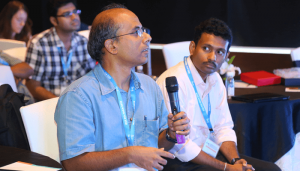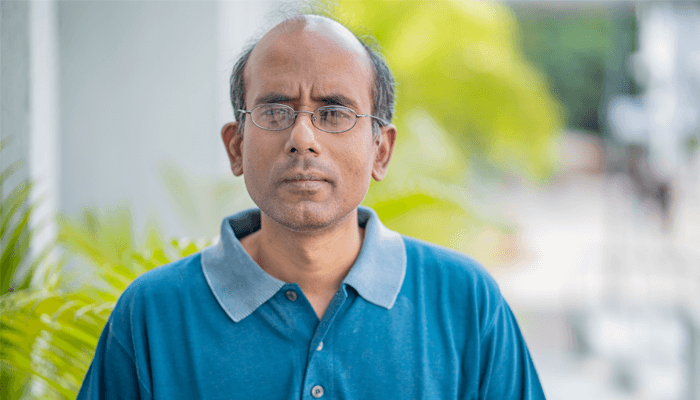In this month’s ‘Know Your Professor’ series, we catch up with Prof. Madhav Krishna. Head of the Robotics Research Centre and the Kohli Center on Intelligent Systems, this self-confessed “shy” professor who would rather let his work do all the talking nevertheless lets his guard down and speaks of his modest beginnings, and life learnings while briefly revealing his philosophical disposition. Here’s an excerpt.
What do you do if you’re an only child growing up in the early ‘80s with very few peers to play with in your neighbourhood? Well, if you’re someone like Prof. Madhava Krishna, you innovate and create your own version of street games like cricket that can be played alone. With the essence of academia being the pursuit of serious, often solitary thought, these early experiences may have played a role in Prof. Krishna’s own academic exploits. “This could have helped but it may seem far fetched. Of course, sometimes as researchers you are alone and situations demand that you think (though collaborative work is more common lately). I was fortunate that during my PhD days, I was not only allowed to create my own problems but also solve them,” he says.
Foray Into Robotics
His earliest steps into a lifelong learning of robotics happened fortuitously at BITS Pilani where he originally enrolled for a BTech degree. BITS then had what is possibly India’s first robotics lab which was set up in 1993. It was very prestigious and with very few other labs on campus, there was a lot of competition to get into it. By working there an entire semester and demonstrating his interest in the initiative, Prof. Krishna was accepted into the lab during his 3rd year. It was this lab that provided him a solid foundation in the areas of electronics, embedded systems and robot building. In many ways, the work and results produced in the lab were ahead of the curve, even in the global context. For instance, they built a robot with a stepper motor and position feedback with a fuzzy logic-based collision avoidance only to understand much later that something similar was attempted at CMU leading to a paper publication in 1997 – a good 3 years after the BITS’ team’s efforts. Speaking of their own endeavours which lacked global attention and consequent approval, he highlights the drawbacks of an academic life prior to the digital age, “We were not aware of what was happening in the global research community. Since there was no internet at that time, we had to go to the library and look at the journals to see what they are saying. The notion of conferences was also not really there. In any case, it wasn’t an online submission the way it has been for the last 15-20 years. You had to send it by post, unsure if it’s going to reach!” But despite the obvious limitations, Prof. Krishna concedes that he was fortunate to be part of the ecosystem at BITS which spawned the pioneering robotics lab.
Teach For MTech
For his higher education, Prof. Krishna continued at BITS in pursuit of a Masters degree, opting to double up as a Teaching Assistant which entailed a waive-off in the tuition fee. It was during this period that he moved away from hardware, gravitating towards algorithms. In hindsight it was a move he would prefer not to have precipitated. “I learned later that eventually everyone moves towards AI but really you need a physically embodied agent wherein your AI can work. If you are not doing that so much, then you are relying more on simulators and you do not know how it is going to work on a real system,” he says, adding that it is a problem that continues to plague robotics though efforts to overcome it exist in the form of really good simulators. Meanwhile, though the Teaching Assistantship was an official position guaranteeing not just a salary but PF payouts too, the flipside was that TAs were not eligible for campus placements. The reasoning was that TAs would continue to eventually transition into lecturers and professors. “The basic source of employment through campus placement was not there for me. It was this situation that forced me to think of a PhD as a career option,” says the professor. And fortunately for him, it was a decision that he could take single-handedly in the absence of familial pressures. Something that he rues is missing for the present generation.
Fast Track PhD
Unlike many others who first finish up their course work and then begin to zero in on a problem for their thesis, Prof. Krishna had spent his undergrad years in formulating various problems. Hence when he was accepted for a PhD at IIT Kanpur, he arrived with his carefully thought out ideas and submitted his thesis within 2 years and 11 months. “The advantage was that I had already thought of these problems when I joined IIT and my advisor, Prof. Kalra was quite kind to let me continue with that.” At Kanpur, while continuing to work on problems concerning navigation, he introduced neural networks to learn how to move amongst dynamic agents, something that is popular even today. A laissez-faire approach by his advisor in his area of research worked out well for Prof. Krishna. However there was a downside to this too. “While my PhD was fast tracked, I didn’t have a peer group. I didn’t know how to interact with others or how to assimilate others’ ideas and integrate that within my setup,” he says. That was a learning that was to come during his postdoctoral research.
Live. Learn. Postdoc
Incidentally, Prof. Krishna has not one but two postdoctoral fellowships under his belt. For his first, he chose to go to Toulouse in France at the Robotics and AI Lab, LAAS-CNRS. While the work he did there was similar to what he was pursuing during his PhD, it brought in the human element into focus. “I worked on safe navigation of robots where the robot has to not only interact with humans, but also learn to manoeuvre in an environment replete with humans in a safe manner,” he says. The biggest advantage for the professor was the professional alignment with the broader robotic community. He was now ‘connected’ in a big lab, with access to weekend seminars where researchers from other European Union labs came in to present their work. Until then Prof. Krishna had been working on single robots and their navigation. When he learned of a researcher pursuing multi-agent navigation at the University of Arkansas, US, he was intrigued and decided to apply for a second post-doctoral fellowship there. “I thought that was a nice addition to what I was doing.” But if he thought he could focus on only expanding his research interests, he couldn’t have been more wrong. “My post-doc grant was funded by Air Force Office of Scientific Research. I had to keep my funding agency happy, I had to do research, I had to teach and as part of teaching, the HoD wanted me to start a robotics lab. That’s how it works in the US, you just have to bite the bullet. The US environment throws you into the deep end which is good,” he remarks with a laugh.

Heading Home
All this served as training of sorts and came to stand him in good stead when he headed back home, opting for IIITH as his base. Interestingly enough, it was his second application to the institute. “I had been hired in 2001 itself when Dr. Narendra Ahuja was the Director of IIITH, “ he says. “But I didn’t join then. I felt I was too raw and wanted to do a post-doc fellowship, and by then the offer from Toulouse had come in.” Hence in 2005, when he came back to India, he knew it was going to be at IIITH again. This time though he was better equipped. “I was aware of the pressure of getting funding and was well versed in the game,” he says. When he was asked to head the robotics lab that had been set up by Prof. Raj Reddy, Turing award winner, and the chairman of IIITH, he had the foresight to apply for funding and arrived on campus armed with a grant from DRDO.
RRC and KCIS
Since 2005, Prof. Krishna has been teaching 3 (or more) courses every year – Mobile Robotics, Advances in Robotics, and Controls. In addition to this, he can be found teaching some core Electronics courses too for undergrads such as Digital Systems or Digital Logic and Processors or an electronic workshop. As head of the Robotics Research Centre, his focus continues to be on navigation. “Navigation for ground robots, self-driving cars and drones – this is what we’ve been doing for the last 5 years and various avatars of it,” he states. While previously, Lidar sensing was used as a sensing modality, the lab is foraying into vision-driven robotics. With new colleagues, Dr. Spandan Roy and Dr. Harikumar who are adept at building drones and controlling them, the professor remarks, “They have a very complimentary skill set to me and we hope the lab will continue to grow and bring in new elements not present before.” More recently, Prof. Krishna has been appointed as the Head of the Kohli Center on Intelligent Systems (KCIS). KCIS is an umbrella entity created in 2016 to coordinate and accelerate activities of the institute in the Intelligent Systems (or “AI”) areas, endowed by TCS Foundation. So far, KCIS had been coordinated by the Dean (R&D) and the Director of the institute. Recognising that it was important to have a faculty member to own it a bit closely in the future to initiate a few high-impact activities, Prof. Krishna was aptly chosen for the role.
Philosophy Of The Mind
While the professor is interested in sports such as cricket, chess, or tennis and even soccer, he admits that he rarely finds the time to watch them. “Maybe I don’t work efficiently enough to find time for indulging in other activities,” he muses. His interests lie in the post-modern notions of the philosophy of the mind and the mind-brain problem. “This is something I spend time on and it also relates to AI and things like the cognitive sciences”. While AI holds great promise as a disruptor, solving some of the world’s greatest problems, it simultaneously carries the threat of
replacing (and in some grim scenarios, overthrowing) humans. For this, Prof. Krishna admits that in instances where manual labour is tough and repetitive, automating it is useful because such labour can be stressful. But in response to the doomsday scenario, he says, “A robot can pretend to or mimic that it can exist but I don’t think a robot is aware of its existence as much as a cell phone is unaware of its existence. If robots were to start having that awareness or ego, then things can be more difficult for us. Taking over …I don’t think humans will allow that. Humans love themselves more than anyone else so they might block that possibility,” he says.

Sarita Chebbi is a compulsive early riser. Devourer of all news. Kettlebell enthusiast. Nit-picker of the written word especially when it’s not her own.


Prof. Krishna have really great and inspiring journey. The article is well written and crafted.
Avi Tomar says:IIITH is very lucky to have professors of Prof. Madhava’s calibre. One of the best introductory courses I took was taken by him and It was a pleasure to learn from him. Thank you for sharing his inspiring research journey. Best wishes!
Anurag Ghosh says:Well written post and very inspiring journey! We are fortunate to have Prof Madhav heading robotics at IIIT!
Shubodh says:Very interesting interview with Prof Madhava krishna. Thanks for sharing.
Sowmya says:Great article
Abhay Singh says:Great Article, and truly an inspiring person Prof. Madhava
aditya says: